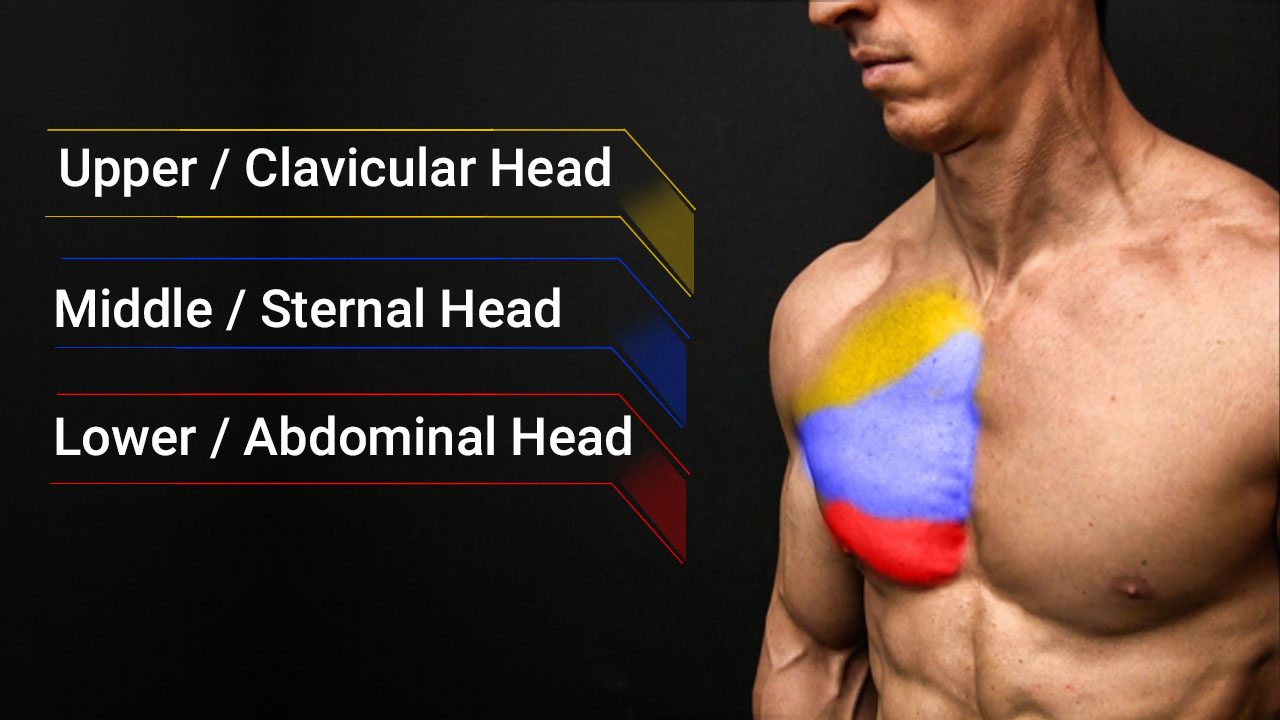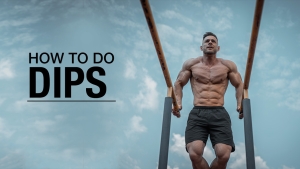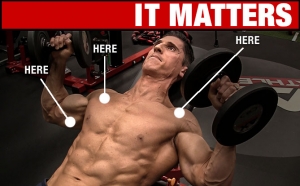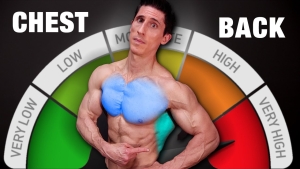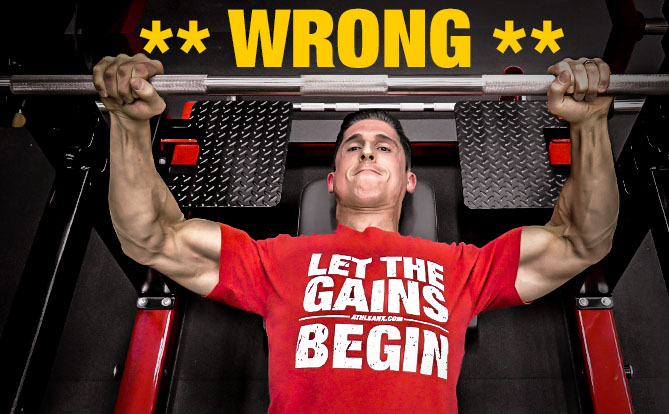
HOW TO BENCH PRESS PROPERLY
The Bench Press can be a double-edged sword.
It’s one of the best compound exercises to add into your workout, but it’s also an exercise that most people do wrong (including you).
And hey, it’s not your fault because there are so many places in the lift that bench pressers can go wrong, especially if you’re using heavy bench press weight.
Not to mention, most people are lifting way beyond their fitness level.
One of my biggest concerns for you and my other readers is balancing the long-term maximum safety of a movement as well as the risk-to-reward ratio of performing the lift. Despite the benefits of the Bench Press, there are plenty of things that can go wrong especially in the shoulders, wrists, elbows and back. It may seem like a basic movement pattern, but the details matter and using bad bench press form can cost you.
But this is assuming you aren’t performing the Bench Press with proper form and technique, and without making some of the common mistakes.
The thing is that you WILL be performing it correctly because I’m going to teach you how to do it with perfect Bench Press form and proper execution.
I’ve put together a basic Barbell Bench Press checklist that I’m going to go through step by step to ensure you nail each portion of this exercise. Not only will this checklist ensure you’re doing it right, but it’ll also help you with building upper body strength in your bench.
Here are the elements of the bench press we’ll be covering:
Before we get into all of the details of proper form, let’s get started with the anatomy of the chest (pectoral) muscles.
ANATOMY OF THE CHEST
This breakdown of your chest muscles of the pectoralis major is going to help you solidify a strong mind-to-muscle connection, which can help with better results.
Why?
When you know EXACTLY which muscle is working, and when you have that strong mental image of the muscle working, you are going to perform better.
Mindlessly moving heavy loads doesn’t do much. All elite lifters know this much. But really focusing on what the muscle is doing – only focusing on that – is going to increase activation. It’ll also help you reach your fitness goals of muscle mass, fat loss, and performance.
It also decreases your risk for getting hurt because you’re actively paying attention to what you’re doing.
Ask any professional bodybuilder. They’ll tell you that to get an insane pump and the results you want, you need to be locked into the muscle.
And that’s why we’re starting with my breakdown of the chest muscles.
What people commonly refer to as “the chest” is actually made up of three distinct areas.
AND depending on which chest exercise you’re doing, and the level or angle of the exercise, you will increase pec activation in one part of the chest more than the others.
For example, when you perform an Incline Bench Press, you’ll activate the upper part of the pectoralis major MORE than the other two sections.
Speaking of the upper part of the chest…
UPPER CHEST / PECTORAL MUSCLES
The upper chest or pectoral muscle fibers are shaped like a fan. They begin at the clavicle and move down toward the arm and diagonally upward toward the center of the chest.

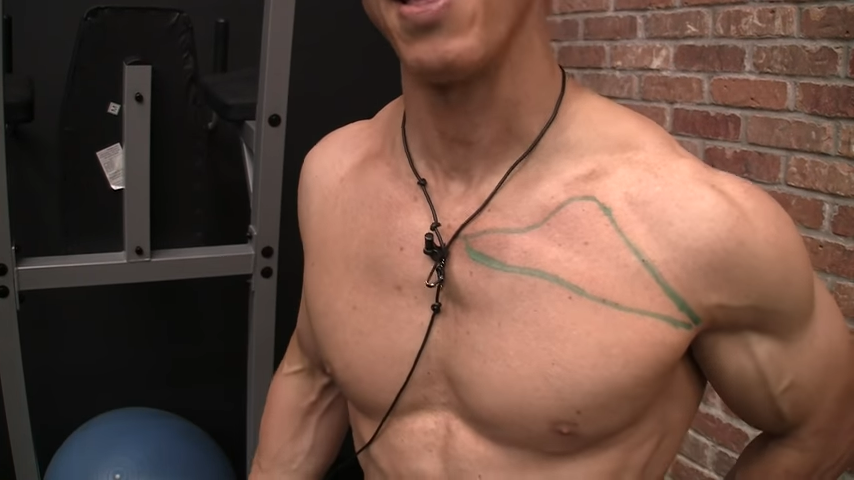
Exercises that are ideal for targeting the upper chest go beyond the basic variations of Bench Presses. Here are some more examples of exercises that activate the upper pecs:
- Incline Bench Press
- Incline Dumbbell Bench Press
- Reverse Grip Incline Bench Press
- Incline Bench Dumbbell Fly
- High-Level Cable Crossover
- Decline Pushups
Thanks to the incline angle of the weight bench and the decline angle of the Push-Up, these exercises will naturally demand more from the upper pecs.
MIDDLE CHEST / PECTORAL MUSCLE
The middle part of the chest muscle starts at the sternum and runs level straight across the chest.

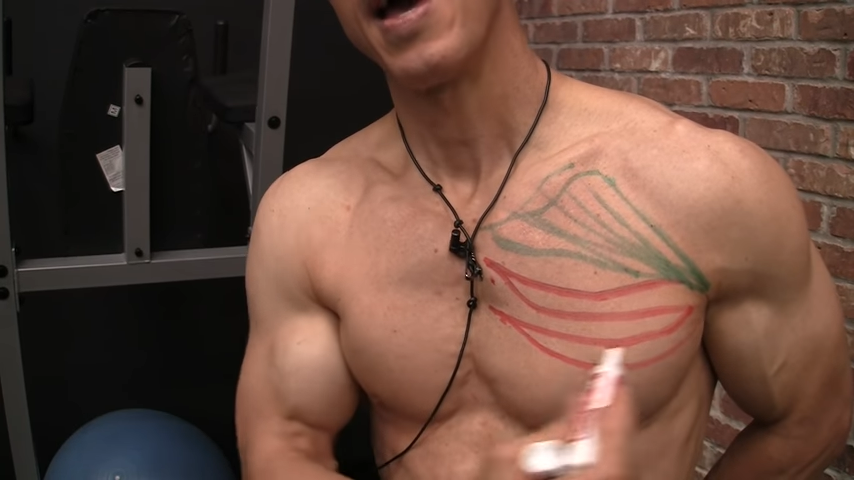
Again, here are some of the best ways to really hit the mid-chest outside of the standard Bench Press variations and the classic powerlifting exercise.
- Barbell Bench Press (Flat Bench Press / Regular Bench Press)
- Dumbbell Bench Press
- Reverse Grip Flat Bench Press
- Flat Bench Dumbbell Fly
- Mid-Level Cable Crossover
- Classic Pushup
LOWER CHEST / PECTORAL MUSCLE
The lower chest muscle is smaller than the other two sections and it is shaped like a triangle.
This part of the muscle begins at the bottom of the sternum, and it runs diagonally down toward the center of the chest.

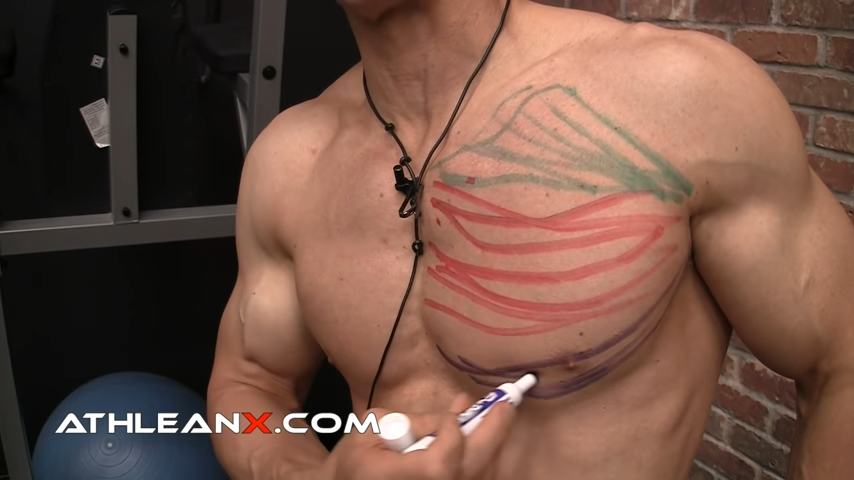
Exercises that are great for activating the bottom portion of the chest include the following:
- Decline Bench Press (Decline Barbell Press)
- Dumbbell Decline Bench Press
- Reverse Grip Decline Bench Press
- Decline Bench Dumbbell Fly
- Low-to-High Cable Crossover
- Incline Push-Up
It should be clear by now that if you want to hit all three sections of the chest, you’ll need to invest in a weight training bench that can shift between decline, flat, and incline.
Incline benches are great but having the option to decline the workout bench ensures a well-rounded build of your chest.
With that said, in the meantime, don’t worry about incline or decline bench pressing. Right now, I want to focus on the traditional Bench Press exercise with a flat level.
HOW TO BENCH PRESS: THE SETUP
It all starts with getting your equipment ready.
Yeah, I get it: This isn’t the most glamorous part of the exercise, but I have to stress the importance of a proper setup, especially for a technically difficult exercise like the Bench Press.
BENCH AND SAFETY
First things first: Where are you benching?
I don’t mean inside or outside, home or gym…
I mean are you using a standalone bench? A basic setup of a workout bench and an attached bench press rack at the top? Or are you able to get inside of a power rack?
I HIGHLY recommend the latter, especially if you’re doing the Bench Press alone. A power rack is the optimal piece of fitness equipment to have because it’ll protect you just in case the weight load falls.
What’s more, a power rack gives you access to Squats, which are another foundational compound movement.
Next up, do you have clips?
I know, I know. Clips can be a personal preference thing. But it doesn’t take to find a gym fails video on YouTube where a guy forgets to clip his weights, adds too much weight load, and… you know the rest. One side lowers a bit too much than the other. The plates start to slide off of one side. Then the other.
Next thing he knows, he’s gone viral. Don’t be this guy.

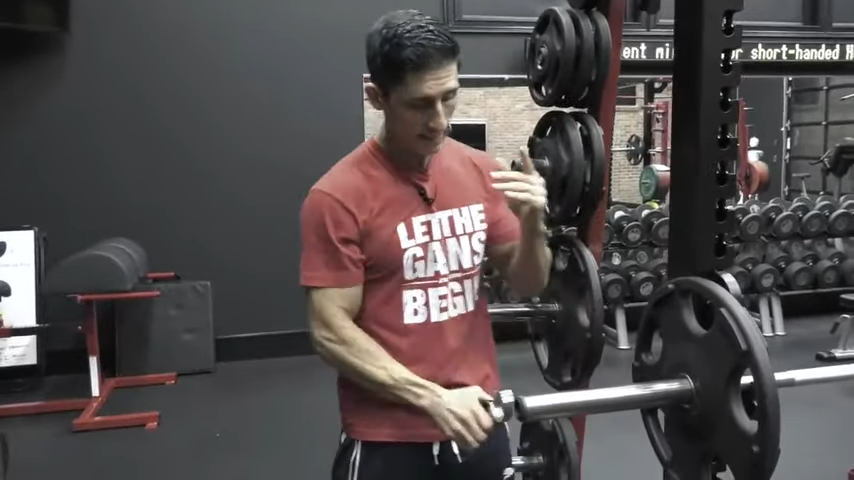
Put the clips on the ends of the bar to protect the people around you should your plates try to slide off.
Now there is ONE exception to this rule.
If you’re lifting alone without a power rack, clips might make it harder to ditch the bar if you’re using heavier weights. Without a spotter, you can opt for using lighter weights without clips. Save the heaviest weights for another day.
BENCH AND BAR POSITIONING
Next, I want you checking the actual placement of the bar in your bench press station.
This probably seems so simple, it’s stupid. And yeah, it is simple, but usually the simple stuff gets overlooked and that is what causes most accidents and injuries.
So, ask yourself, “What is the placement of the bar in the rack itself? Is it centrally located?”

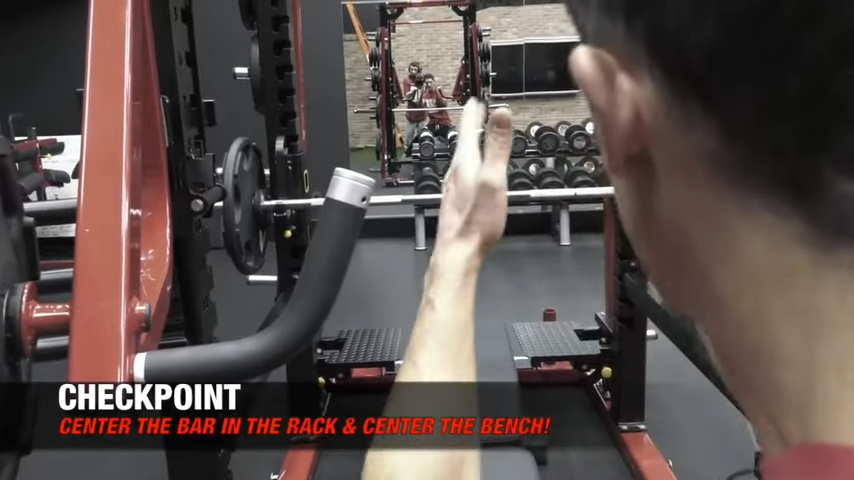
A lot of times you’ll walk up to a heavy barbell on a weight bench, and you’ll find it favoring one side far more than the other.
If you were to start the exercise with a bar that’s off center, you’re already beginning at a disadvantage because it’ll throw you off.
Once the bar is lined up in the rack, look down the length of the weight bench. Your goal should be to place the bench in the middle of the knurling of the bar.
What’s a knurl?
Did you ever bash your shin against the pointy, kinda’ sharp sections of an Olympic barbell? You know, those marks that can be found usually in three separate sections spread throughout the barbell? You want to make sure that the workout bench is lined up perfectly in between those marks.
HOW TO BENCH PRESS: ON THE BENCH
Finally, it’s time to get on the bench and look at your starting position. We’re not benching yet, but we are getting closer.
Again, I want you to focus on aligning yourself perfectly into a proper position that allows you to maximize performance while minimizing risk.
So, go ahead and sit on the workout bench…
BENCH-TO-BODY RATIO
As you slide yourself up, you literally want to be staring right up at the bar.

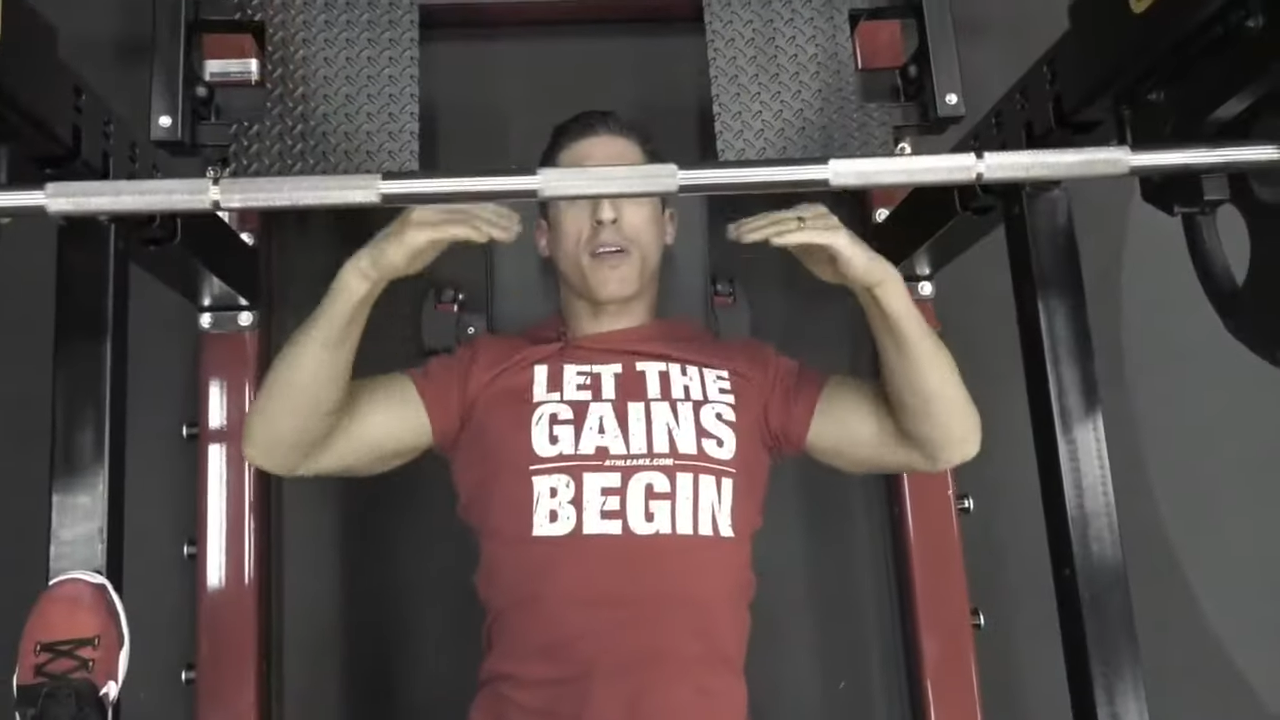
As you can see in the picture above, my eyes are literally lined up with the bar in this position.
The great thing about aligning your eyes with the bar is that it sets you up for perfect form during the liftoff position. At the same time, you want enough room on the bench to accommodate your head.
You do NOT want your head leaning off the back on a bench.
Speaking of which…
HEAD POSITIONING
While you don’t want your head hanging off the bench, you ALSO don’t want to push your head back into the bench.

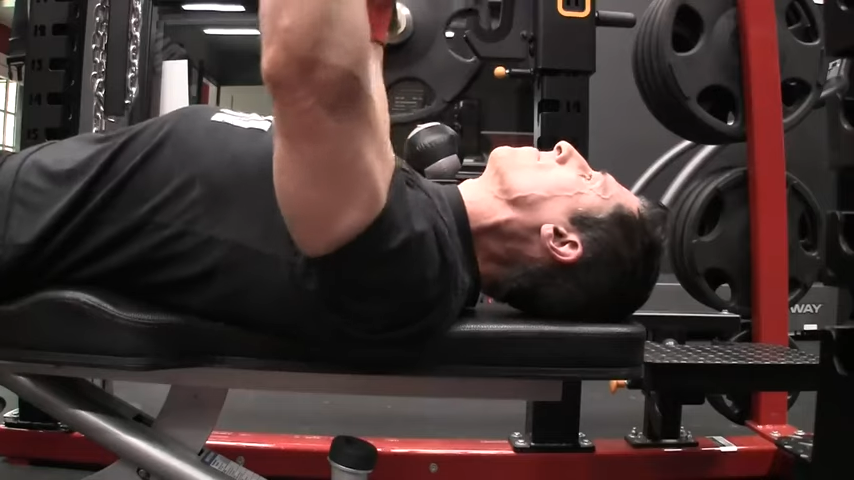
I’ve seen guys to do this to try to help generate more force into the barbell and help their lift.
And guess what: It doesn’t work.
However, it WILL put you at a higher risk for strain or injury. Not to mention, it hampers your performance.
SHOULDER POSITIONING
Working our way down the body, we come to our shoulders in our bench press training.
If you’re like most people, you’ve probably heard that you need to retract your shoulders before you bench. After all, scapular retraction creates a tightness and a foundation to generate more force.
Problem is that most people try doing this and they end up moving their shoulders into a shrugging position. This bad position creates weak shoulder muscles, and it can potentially put your shoulder joint mobility at risk for injury. At the least, you might experience pain in your shoulder muscles.
Instead, you want to focus on bringing the shoulders down and together.

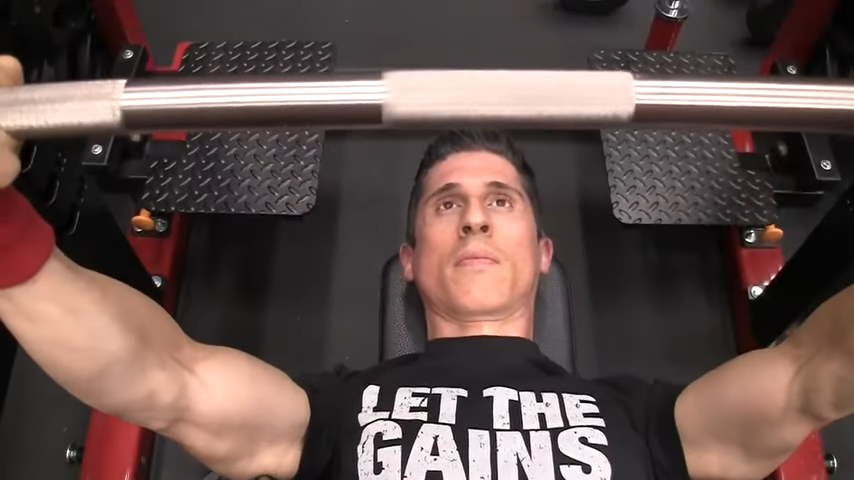
This will put your shoulders in a better position, correcting the position of the elbows during the descent, and decreasing the risk of shoulder impingement.
UPPER BACK AND SCAPULAE
Now we get to our upper back and scapulae.
This might seem counter intuitive since we are working on a chest exercise, but as I’ve mentioned before, the entire body plays a part in perfect benching form.
As I talked about above, the goal of shoulder retraction (pulling shoulders down and together) is to create tightness throughout the upper body, especially the back. This helps to generate more force and upper-body strength during the lift.

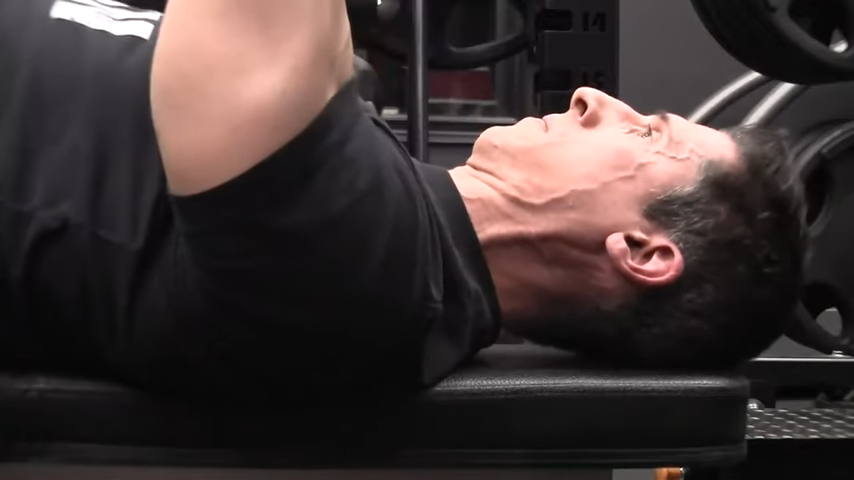
You want to focus on tightening your back, NOT shrugging the shoulders, in order to create a solid foundation.
And this allows you to generate more effort and force, which in turn can help you push the barbell up from your chest.
ELBOW POSITIONING
The position of the elbow is going to be key.
You don’t want to bench with your elbows up high in a guillotine position because you’re going to have a tougher time with pulling off a proper bench. The exception would be if you’re doing the guillotine press, but that would require far less weight load than your average Flat Bench Press.
Back to the bench: If you are in a guillotine position during a Traditional Bench Press, you’re leaving yourself no room for the rotator cuff muscles to properly function.
Even worse, if the weight gets a little heavy and the bar path starts to go forward, you’re going to get internal rotation in the shoulder. The result of this bad bar path? You’re going to cause serious injury to the rotator cuff.
You don’t want flared elbows during the Bench Press, so where should your elbows go?
Your elbows should be around a 75-degree angle away from your body. You don’t want to tuck your elbows you don’t want to flare them either.

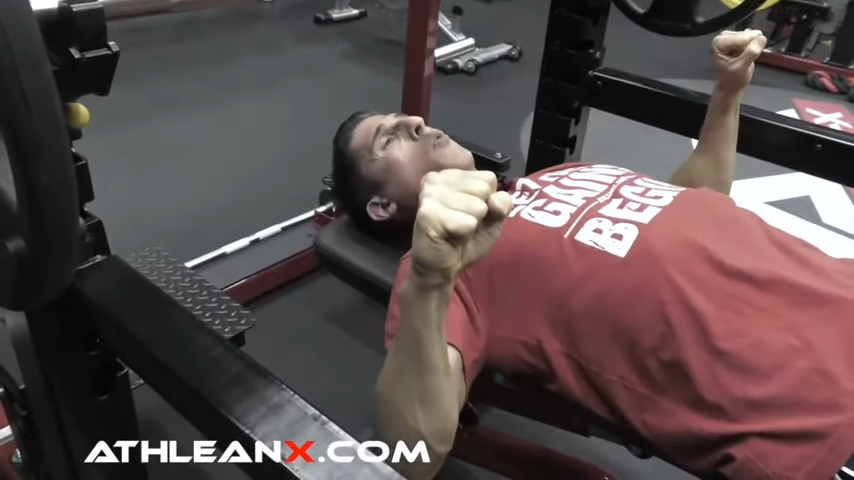
Again, when you perform the Bench Press, you DO NOT want the elbows to travel high because it poses a serious risk to your shoulders.
As you move your elbows out from the body, check-in with yourself and be sure to decompress those shoulders and pull those traps down.

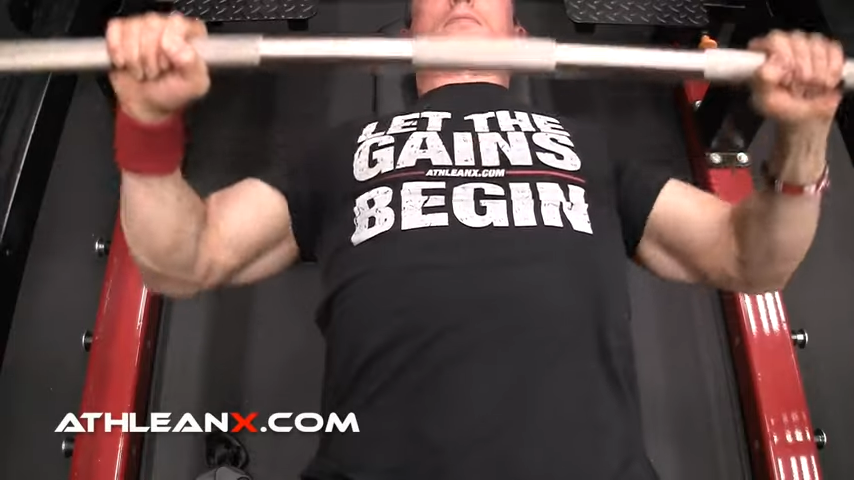
Proper positioning of your elbows also allows you to push with more force.
GLUTES
Glutes aren’t just reserved for Barbell Squats.
You want to contract your glutes during the Bench Press because this will help with generating maximum strength and force in the opposite direction from the floor.


Drive your flat feet down as you push the bar away.
You’ll notice that you create equal and opposite forces, allowing you to perform the Bench Press with more efficiency.
BAR GRIP
As far as your bench grip, you want to know two things: Grip type and grip width.
What is the common type of grip? Should you use a narrower grip or a wider grip barbell bench press?
A narrow grip will encourage triceps brachii muscle activation more while a wide grip will impact your elbow positioning. There’s a thumbless grip, also called the Suicide Grip, that some people will use because they want to look cool when they do it.
Problem is, what happens if the bar slips out of your hands and rolls forward with this thumbless grip? They’re in trouble.
Instead, you should always focus on having your thumb wrapped around the bar. The thing is that it’s not as simple as just grabbing the bar.
Most people will approach grabbing the bar from the top, using an overhand grip. That is, their hands will wrap around the bar starting with lying their fingers on the top of the bar then wrapping the hands underneath.
If you wrap from above, the issue is that the bar is too high on my fingers. It’ll look like a wrist curl.
So, when you lift off, the bar is going to roll backward and take the support of your forearms out of the exercise. This will increase the likelihood that you will hurt your wrist joint.
Again, NOT good.
So, what you want to do is come from underneath the bar, NOT over the top.

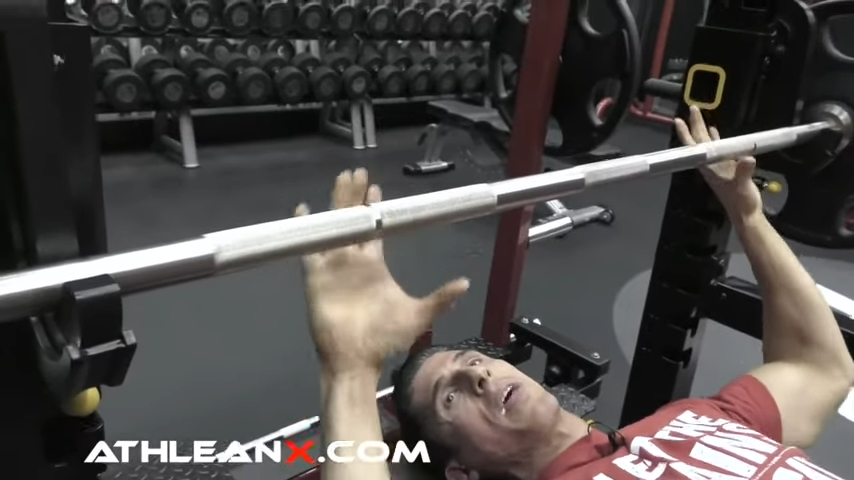
When you grab the bar from underneath, the bar is lower on your hand, and you can wrap around to the right position.
Now when you lift off, you’ll have a fully supported bar because your forearm is directly underneath the weight.
KNEES AND FEET POSITIONING
Now, let’s talk about what your knees and feet should be doing during the Bench Press.
Place each foot underneath each knee so that they can actually push. You want your feet flat on the ground.

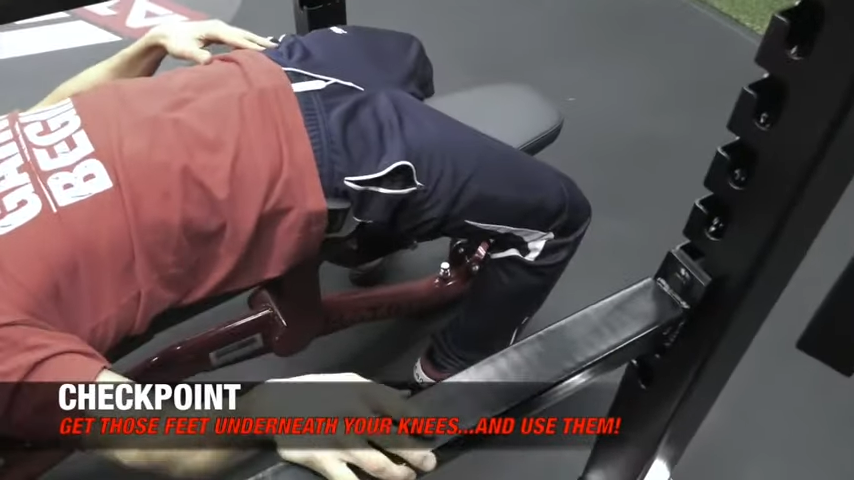
POSITION OF YOUR CHEST
Let’s travel back up the body to the main muscle of the hour: the chest.
All the major muscles of the body have been accounted for, so what should you be doing with your chest?
First, you want to pull your shoulder blades down and back while maintaining a neutral spine. That’s why you want to have them underneath of your knees.

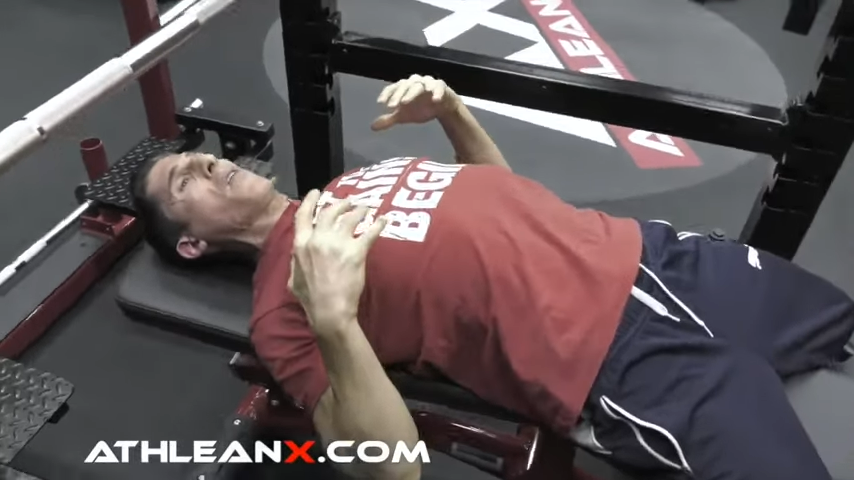
This creates a stable base that you can actually push off of.
Second, by doing this with the shoulders, your chest will naturally move up, and that’s what we want. We want there to be a strong foundation for your upper body to push back on AND we want the chest up.
TIGHTEN THE ABS
Continuing with the point above, let’s keep the chest where it is and plug those energy leaks by keeping the core tight.


When you maintain core stability in your abs muscles including the rectus abdominis and transverse abdominis, you won’t have any energy leaks throughout the kinetic chain.
Let’s go through that checklist one more time:
- Grips comes from underneath and locks onto the bar
- Press through the feet
- Tighten the glutes
- Press through the back
- Chest goes up
- Tighten the core / Maintain core stability
And now, we’re ready to lift off.
HOW TO BENCH PRESS: THE LIFTOFF
When we get ready to lift off, where are we lifting from?
If you’re grabbing the bar and there is no bend in your elbows, the catch on the barbell rack is too high. If you have a fully straightened arm and locked elbows because the catches of the rack are too high, that means you have no lifting power.
You won’t be able to lift the bar from the barbell rack.
You need to lower the catches of the rack to a proper height so that there is a slight bend in the elbow joint (unlocked elbows), which will allow you to push off THEN straighten your arm to its full range of motion.

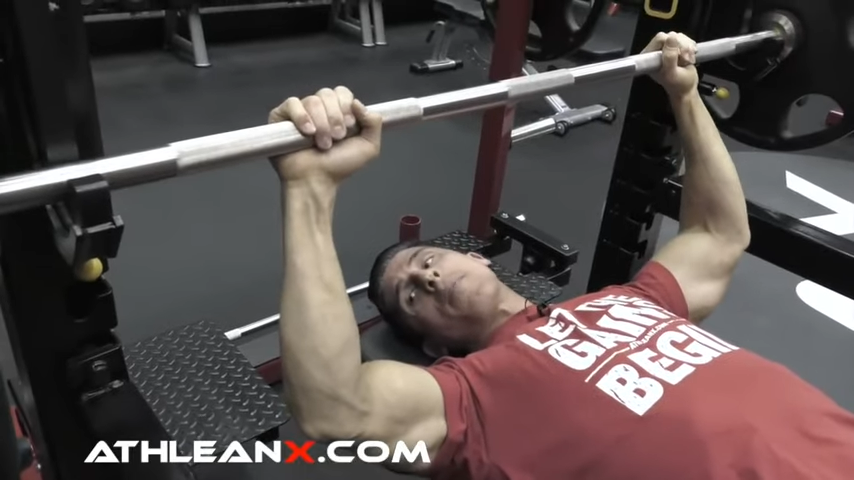
With that said, you don’t want to lower it too much either.
If you go too low, you’re going to lose strength because it’ll take more effort to push the bar up and away.
BAR PATH
Bar path refers to the direction that the barbell is moving during Bench Presses.
The goal is to create a straight vertical bar path but that doesn’t necessarily mean straight up and down. It means straight at an angle. In other words, a straight diagonal bar path.


When the barbell is directly above the shoulder blades, it’s in a position of stability. As you lower the barbell, it travels down and hovers above your lower chest.
It has created a straight angle of descent.
When you’re ready to push the barbell back up, you want to get back to that position of stability.
The thing is that you don’t want to press the barbell directly straight and upward in a strict vertical bar path. This bad bar path will strain and stress the front delt. So, the ideal barbell path needs to be angled, which means the bar path is going to have to come forward a little bit.
I can’t stress this enough, guys:
Keep your elbows in, NOT up.
If your elbows are elevated and you hit the bar path correctly, you’re in trouble because you’re internally rotating the shoulders. That’s how you really hurt your shoulder and cause future shoulder issues (like I did).
So, you want to make sure you’ve got elbow positioning AND bar path properly lined up.
PUSH-UP CHECKLIST: TEMPO / PAUSE
Last but not least, let’s talk about tempo or how quickly you move the barbell during the Bench Press. Paying attention to the speed or tempo of the lift will help you focus on the entire movement quality of your repetitions, NOT the quantity.
As you bench, you don’t want to bounce the bar off your chest, especially if this is your trick for trying to lift max weight.
When you reach the bottom of a Bench Press, take some extra time and pause for a moment for going back up into extension.


Hold the bar against your chest for a split second and then push back from there.
Do this for every repetition and when it’s time to rack the bar, let your arms go back, engage the barbell rack, and land it straight back down.
On paper, the Bench Press isn’t the most complex movement, but this classic chest builder IS one of the most dangerous lifts to do because there’s so many places that you can go wrong.
And having injured my shoulder doing the Bench Press wrong, I can tell you from experience that you need to know what you’re doing.
Make sure to follow my Bench Press checklist during your weekly routine in order to see some serious gains from this effective exercise.
If you’re looking for a training program that takes all the details of form and efficiency into account, check out our ATHLEAN-X programs and let me be your coach!

- If you want a strong bench, you need to make sure that you have a proper set-up before you execute the Bench Press.
- Center the bar and bench as well as your body. Don’t use one sided benching.
- Make a strong foundation with your shoulders against the bench but do NOT shrug your shoulders.
- Keep your lungs at a 75-degree angle away from the body. Do not flare your elbows or raise them too high.
- Come from underneath to secure your grip and make sure there is still some bend in your elbow before lifting off.
- As you lower the barbell, maintain a straight diagonal bar path.
- Rest at the bottom of the Bench Press for a moment (2-3 seconds if you want to maximize intensity), then push back to full extension.
BENCH PRESS FAQS
The flat barbell bench press exercise helps to build muscle development in some of the largest muscles in your upper body, the pectoralis major. As a compound exercise, you can use increasingly heavier loads over time to continue to create muscle hypertrophy to build bench press strength and muscle size over time. If you find that you have muscle imbalances in the chest, you can use a pair of dumbbells to help even this out. Be sure to observe proper bench press form to avoid risk of injury.
The flat barbell bench press exercise is a great exercise for the training goal of chest development, because you can create overload and muscle hypertrophy by increasing your weight as you get stronger. The average lifter and even advanced lifters would want to stick to 1-2 bench pressing sessions per week to allow enough recovery time for muscles to grow. Be sure to observe proper bench press form to avoid risk of injury.
It's best not to do the bench press exercise everyday because you wouldn't be giving your muscles enough time to recover to allow for complete chest development. The average lifter and even advanced lifters would want to stick to 1-2 bench pressing sessions per week. Be sure to observe proper bench press form to avoid risk of shoulder injuries.
It's best not to do the flat barbell bench press daily because you wouldn't be giving your muscles enough time to recover and grow. The average lifter and even advanced lifters would want to stick to 1-2 bench pressing sessions in their weekly routine.
Before you load up the bar with heavy weights, the ultimate goal is to make sure you're using proper form for bench pressing so you can experience massive gains. Here are the steps to a safe and effective bench press:
- Place the bar in a power rack and lie on a flat bench with the bar directly underneath your eyes. The bar should be set at a height to allow for your elbows to be slightly bent when you go to grab it.
- Your head should be planted on the bench and your shoulders should be retracted as you reach for the bar. Feet should be flat and pressing into the floor.
- Grab hold of the bar with your thumb wrapped around the bar, and make sure your elbows are at a 75-degree angle away from your body and that your glutes and abs are engaged.
- As you lower the barbell take a brief pause at the bottom point.
- As you lift the bar, straighten the arm to its full range of motion at the top point. The bar path with be a diagonal straight line from directly above your shoulder blades at the top point to above your lower chest at the bottom.
Before you load up the bar with heavy weights, it's important to make sure you're using proper form for bench pressing to avoid shoulder pain and injuries so you can experience massive gains. Here are the steps to a safe and effective bench press:
- Place the bar in a power rack and lie on a flat bench with the bar directly underneath your eyes. The bar should be set at a height to allow for your elbows to be slightly bent when you go to grab it.
- Your head should be planted on the bench and your shoulders should be retracted as you reach for the bar. Feet should be flat and pressing into the floor.
- Grab hold of the bar with your thumb wrapped around the bar, and make sure your elbows are at a 75-degree angle away from your body and that your glutes and abs are engaged.
- As you lower the barbell take a brief pause at the bottom point.
- As you lift the bar, straighten the arm to its full range of motion at the top point. The bar path with be a diagonal straight line from directly above your shoulder blades at the top point to above your lower chest at the bottom.
Before you load up the bar with heavy weights, it's important to make sure you're using proper form for the bench press to ensure proper chest activation, achieve massive size gains and avoid shoulder pain and injuries. Here are the steps to a perfect bench press:
- Place the bar in a power rack and lie on a flat bench with the bar directly underneath your eyes. The bar should be set at a height to allow for your elbows to be slightly bent when you go to grab it.
- Your head should be planted on the bench and your shoulders should be retracted as you reach for the bar. Feet should be flat and pressing into the floor.
- Grab hold of the bar with your thumb wrapped around the bar, and make sure your elbows are at a 75-degree angle away from your body and that your glutes and abs are engaged.
- As you lower the barbell take a brief pause at the bottom point.
- As you lift the bar, straighten the arm to its full range of motion at the top point. The bar path with be a diagonal straight line from directly above your shoulder blades at the top point to above your lower chest at the bottom.
If you are feeling a bench press more in your arms than in your chest, you are probably using too narrow of a grip. To ensure proper chest activation and maximum size gains with bench presses, widen your grip slightly to help engage your chest. Make sure you are using proper form before loading the bar with heavier weights. Bench presses with bad form are less likely to help you build strength and are more likely to cause injury.
If your bench press is weak, it's likely because you are loading up with heavier weights before ensuring you're using proper bench press form. Bench presses with bad form are less likely to help you build strength and are more likely to cause injury. To work on building strength, ensure you are using proper form before loading the bar with heavier weights.
REFERENCES

Jeff Cavaliere M.S.P.T, CSCS
Jeff Cavaliere is a Physical Therapist, Strength Coach and creator of the ATHLEAN-X Training Programs and ATHLEAN-Rx Supplements. He has a Masters in Physical Therapy (MSPT) and has worked as Head Physical Therapist for the New York Mets, as well as training many elite professional athletes in Major League Baseball, NFL, MMA and professional wrestling. His programs produce “next level” achievements in muscle size, strength and performance for professional athletes and anyone looking to build a muscular athletic physique.
















